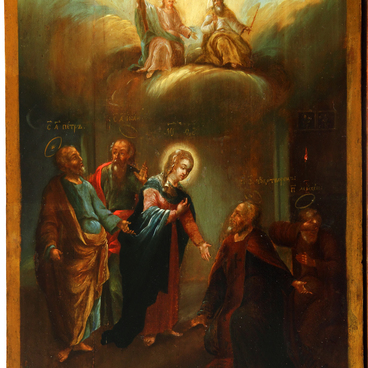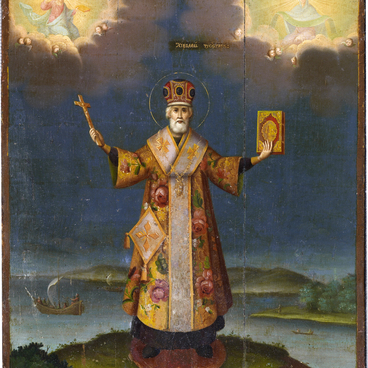The Solovetsky Monastery was founded by the Reverends Sabbatius and Herman, who settled on the Solovetsky Island in the White Sea in the early 15th century. Later, after Sabbatius death, the Reverend Zosima arrived. He built the first wooden church and became the monastery’s hegumen in 1452. In 1547, the founders of the Solovetsky monastery, Sabbatius and Zosima, were canonized, and sometime later the Reverend Herman, too, was canonized “for many years of fasting feats”.
Solovetsky Abode of Wonder Workers
Creation period
2nd half of the 17th century
Dimensions
31.3х27 cm
Technique
Wood, tempera
Collection
Exhibition
4
Open in app#1
Unknown Author
Solovetsky Abode of Wonder Workers
#2
#3
About icon
#4
In the icon called Solovetsky Abode of Wonder Workers, owned by the Rybinsk Museum, the monastery plays the principal role. Iconography like that was unusual for the 17th century, the time of the painting. It is a fancy depiction of the monastery. The scene is viewed from Prosperity Bay and the Holy Gate. The icon painters, however, did not paint the side walls, marked the churches with patronal icons, and portrayed the Saviour Transfiguration (Preobrazhensky) Cathedral as a tower although it is a five-domed structure. Next to it, the painters showed decorative bell gables with two monks tolling bells.
#5
In the foreground, there is a canal with huge fishes and water fowl. Such canals did exist in the older history of the monastery, but experts believe this particular canal to have a symbolic meaning where the fishes stand for Christians’ souls and the water fowl drinking water signify people listening to Christ’s teaching. The saint wonder workers’ figures, albeit present in the icon, are too small to dominate the composition.
#6
The icon in question was assumably made by artists of the Solovetsky Monastery itself. In 1615, the monks built an icon painting chamber in the monastery, whose products included simple icons for pilgrims and sophisticated “gift” icons for important visitors. The Solovetsky Monastery of Wonder Workers is classified by experts as the latter type, which is clear from the harmonious combination of colours, skillful fine lines of miniature painting, and elaborate gilding. Gift icons were not unique – artists could make two or three copies of the same. For instance, a similar iconography picture made by Solovetsky artists at the same time is now on display at the Icon Museum of Recklinghausen, Germany.
The icon arrived at the Rybinsk Museum Reserve from the village of Petrovskoye owned by the Mikhalkovs, a Russian nobility family. It may be that a Mikhalkov visited the Solovetsky Monastery and was given the icon as a gift.
#7
Rybinsk Museum Reserve
read morehide
00:00
00:00
1x
Solovetsky Abode of Wonder Workers
Creation period
2nd half of the 17th century
Dimensions
31.3х27 cm
Technique
Wood, tempera
Collection
Exhibition
4
Open in app
Share

